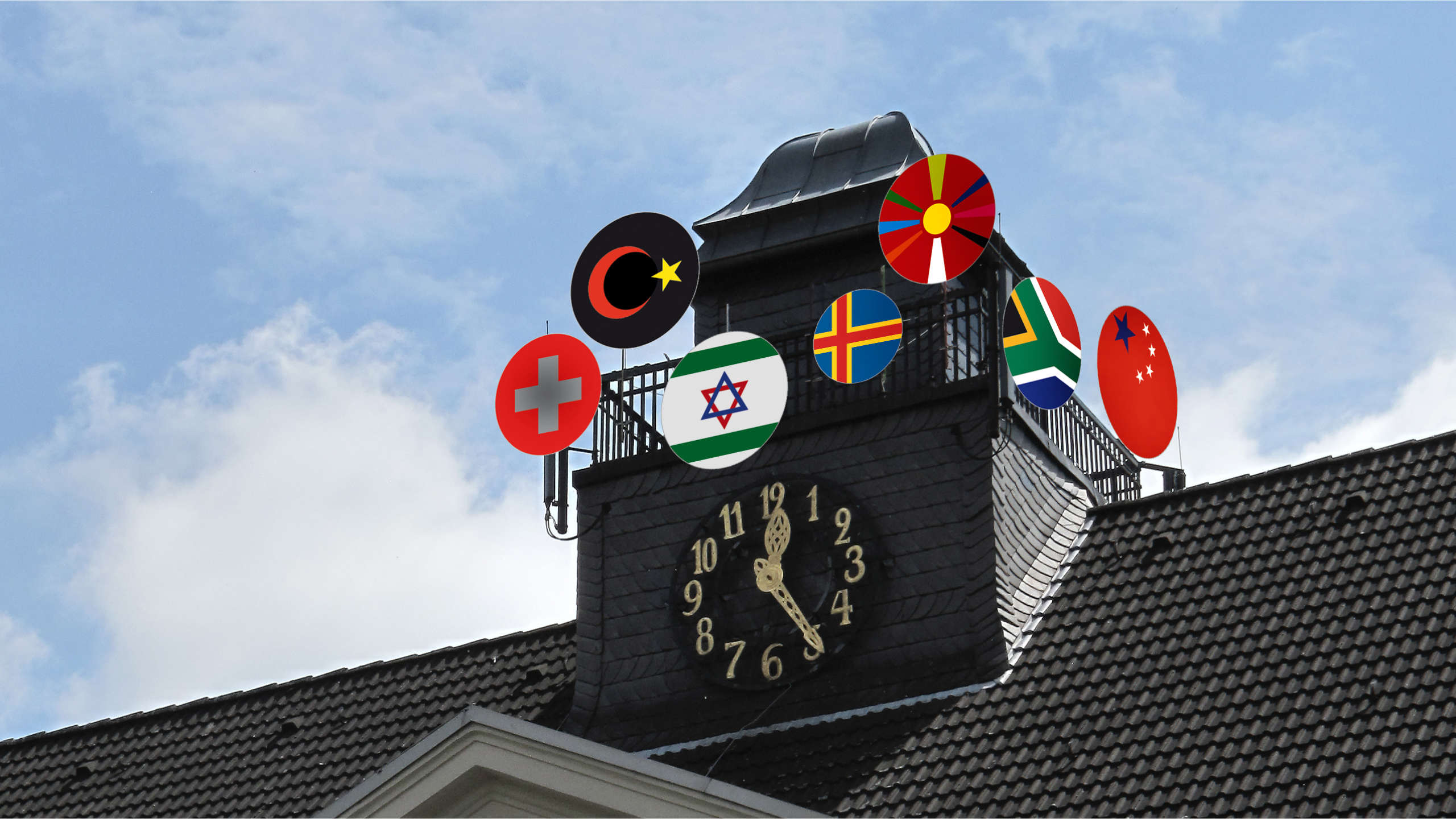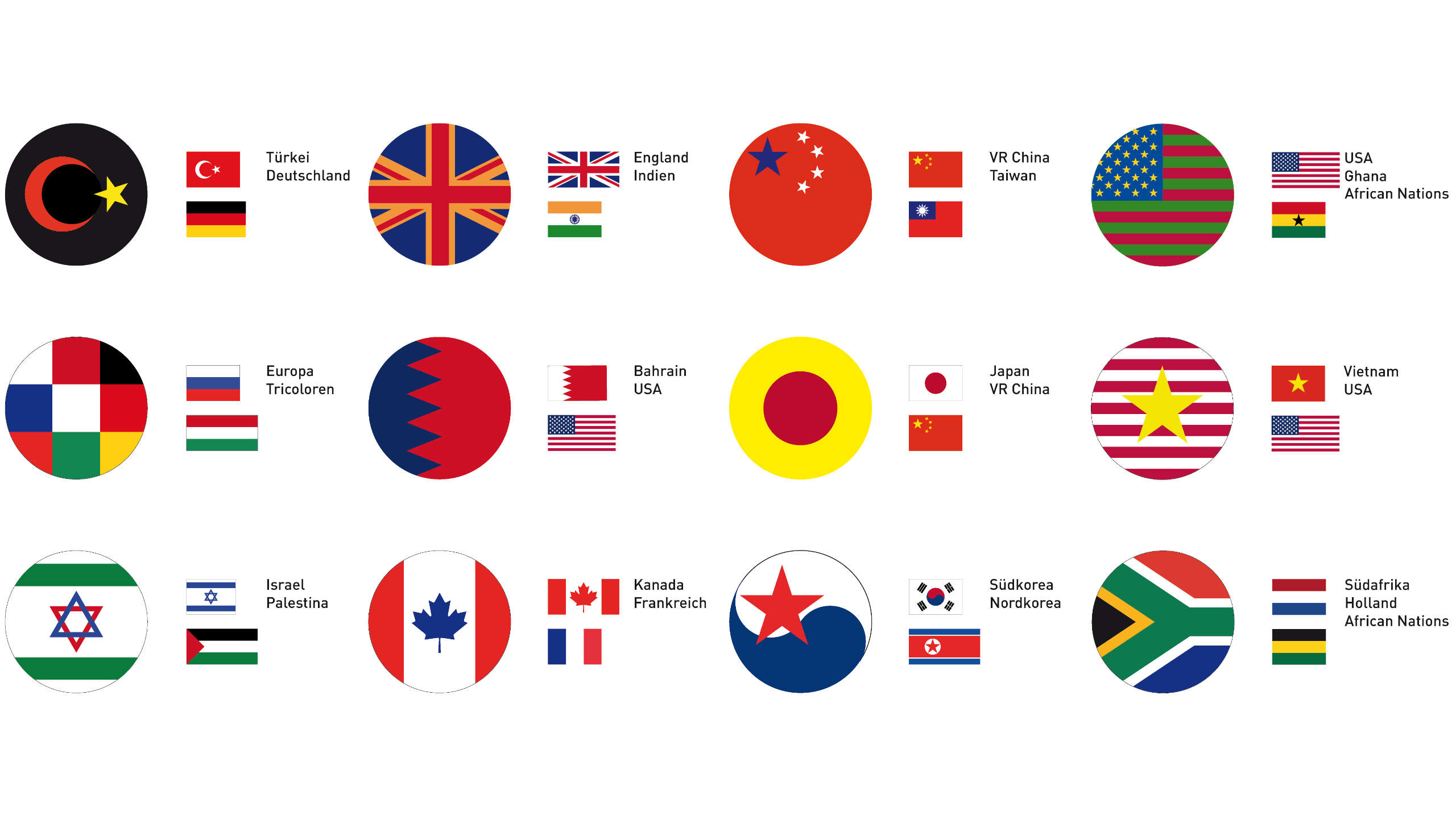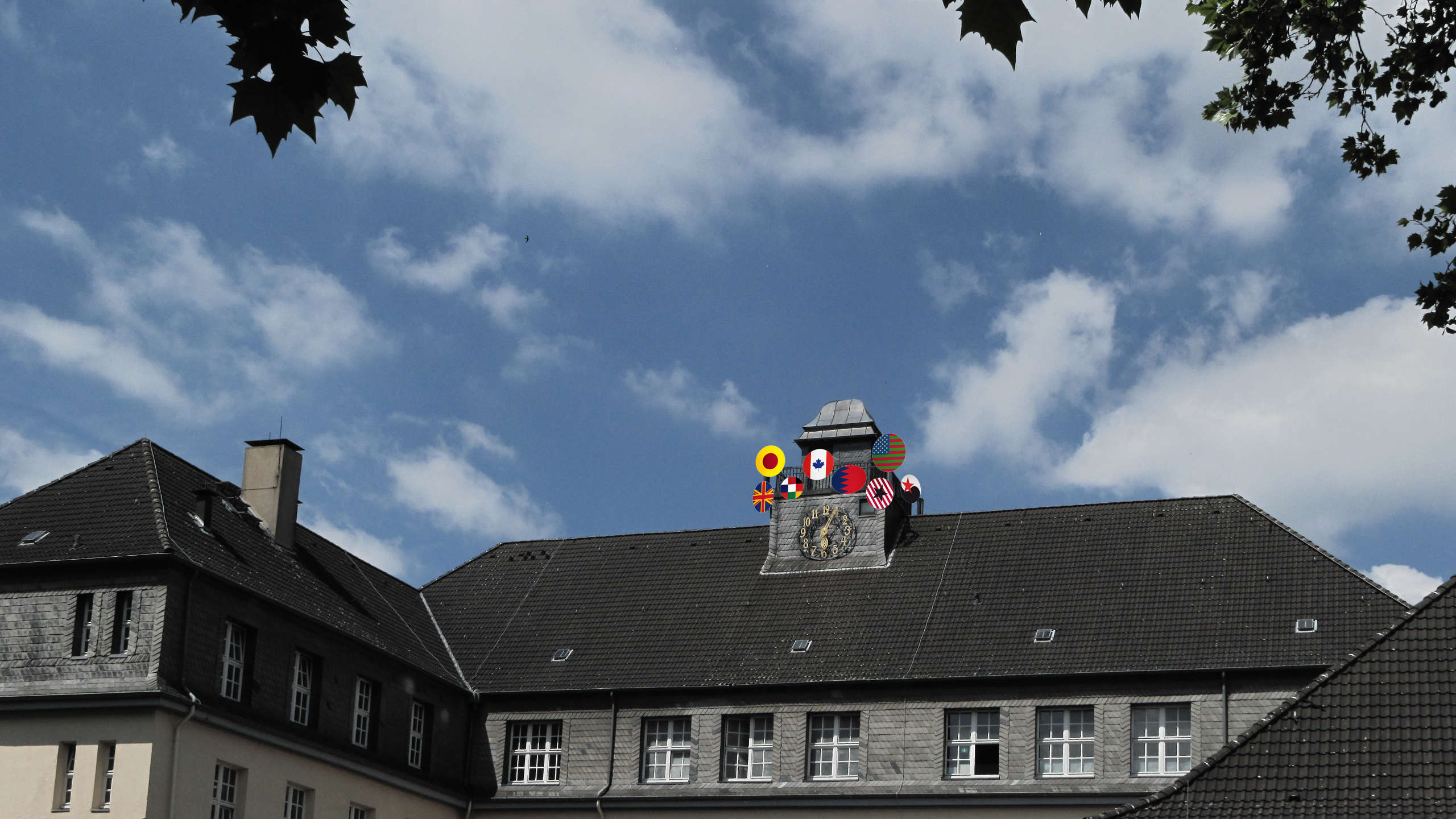Studio Hildebrand
Mag.Art. Christoph Hildebrand
+49 0163 5810594
ch@studio-hildebrand.net




Mag.Art. Christoph Hildebrand
+49 0163 5810594
ch@studio-hildebrand.net










Neuerdings stößt der Passant beim Gang durch die Zechensiedlung Gottfried-Wilhelm auf eine Ansammlung von Satellitenspiegeln auf dem Uhrturm des Kunsthauses. Erst einmal nichts sonderlich Ungewöhnliches in einem Arbeiter-Viertel mit vielen zugezogenen Gastarbeitern. Doch zwei Umstände irritieren und nehmen den Betrachter gefangen. Zuerst fällt die ungewöhnliche Lackierung der ‚Schüsseln’ auf, die an bekannte Nationalflaggen erinnert. Beim zweiten Blick stört, dass die Farbcodes der einzelnen Nationalitäten durcheinander geraten sind. ‚Zufall oder Plan?’ fragt sich der Betrachter. So erscheint etwa die türkische Flagge, eindeutig erkennbar an Halbmond und Stern, in den deutschen Farben Schwarz, Rot und Gold, die israelische Flagge wiederum in den Farben des palästinensischen Staates und die chinesische Fahne zeigt sich in der Farbpalette Taiwans.
Über Satelliten halten ausländische Mitbürger Kontakt zu dem Kulturkreis in dem er aufgewachsen ist und von dem er geprägt wurde. Der Heimatsender ist die Nabelschnur, die er nie durchschneidet. Parabolspiegel zum Empfang von Fernsehprogrammen aus aller Welt an den Balkonen und auf den Dächern in Wohnvierteln mit hohem Ausländeranteil legen davon ein beredtes Zeugnis ab. Der Gast im eigenen Land ist aber selbst ein Sender seiner Kultur und die Menschen des Gastlandes die Empfänger. Das gilt umgekehrt ebenso für den Tourist im Urlaubsland.
COLORS ist zunächst ein Bild dafür, dass wir alle Sender und Empfänger verschiedener Kulturen sind, egal ob wir zu Hause leben oder in der Fremde unterwegs sind. Der bunte Strauss von Schüsseln auf dem Dach zeigt, dass die Vielfalt zuvorderst ein großer zivilisatorischer Reichtum ist – auch wenn sich die kulturellen, religiösen, politischen und ökonomische Systeme im Prozess der gegenseitigen Durchdringung im täglichen Leben aneinander reiben. Jenseits des viel diskutierten und lokal nur streckenweise geglückten Multi-Kulti lenkt COLORS mit der anarchisch-subversiven Strategie der Flaggen-Kreuzung den Fokus auf eine globale gesellschaftspolitische Ebene: Ist der Nationalstaat, wie er im 19. Jahrhundert begründet wurde, noch das Modell der Zukunft? In einer globalisierten Welt kann es homogene Staatsgebilde nicht mehr geben. Wie viele militärische Konflikte in Vergangenheit und Gegenwart zeigen, war dieses schon immer ein zweifelhaftes Ideal, das es in der Realität sowieso nie gegeben hat.
//
Recently, the passer-by walking through the Gottfried-Wilhelm coal-mining estate comes across a collection of satellite mirrors on the clock tower of the Kunsthaus. At first, nothing particularly unusual in a working-class neighbourhood with many immigrant workers. But two circumstances irritate and captivate the viewer. First, the unusual painting of the ‚bowls‘, reminiscent of well-known national flags, is striking. At second glance, it is disturbing that the colour codes of the individual nationalities are mixed up. ‚Coincidence or plan?‘ the viewer asks himself. For example, the Turkish flag, clearly recognisable by its crescent and star, appears in the German colours of black, red and gold, the Israeli flag in the colours of the Palestinian state and the Chinese flag in the colour palette of Taiwan.
Via satellites, foreign fellow citizens keep in touch with the cultural circle in which he grew up and by which he was shaped. The home station is the umbilical cord that he never cuts. Parabolic mirrors for the reception of television programmes from all over the world on balconies and roofs in residential areas with a high proportion of foreigners bear eloquent witness to this. But the guest in one’s own country is himself a transmitter of his culture and the people of the host country are the receivers. The same is true for tourists in their holiday destinations.
COLORS is first of all an image of the fact that we are all transmitters and receivers of different cultures, whether we live at home or are travelling abroad. The colourful bouquet of bowls on the roof shows that diversity is first and foremost a great civilisational wealth – even if cultural, religious, political and economic systems rub up against each other in the process of interpenetration in daily life. Beyond the much-discussed and locally only partially successful multi-culti, COLORS directs the focus to a global socio-political level with the anarchic-subversive strategy of flag-crossing: Is the nation-state, as it was founded in the 19th century, still the model of the future? In a globalised world, homogeneous state structures can no longer exist. As many military conflicts in the past and present show, this has always been a dubious ideal that never existed in reality anyway.
T E M P O R A R Y Uhrenturm am Kunsthaus in Essen 2011 – 2019 + D E S I G N 12 satellite dishes / diameter 60cm, 80cm, 100cm / LED / paint / aluminium / digital control + S U P P O R T Kunsthaus Essen Christoph Kammer Dr. Uwe Schramm City of Essen + M E D I A 7 images © Christoph Hildebrand + T A G S LED / Cluster / Urban / Temporary / +
